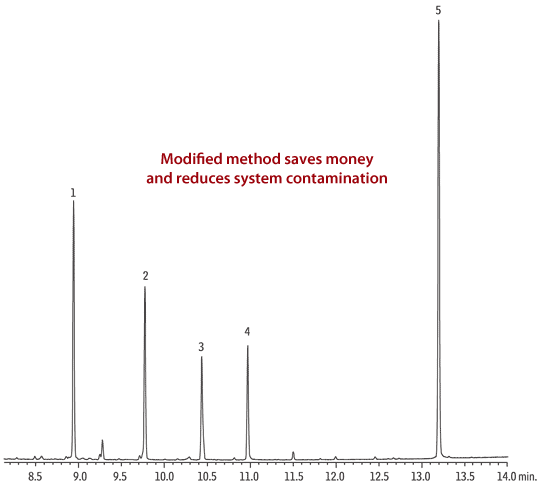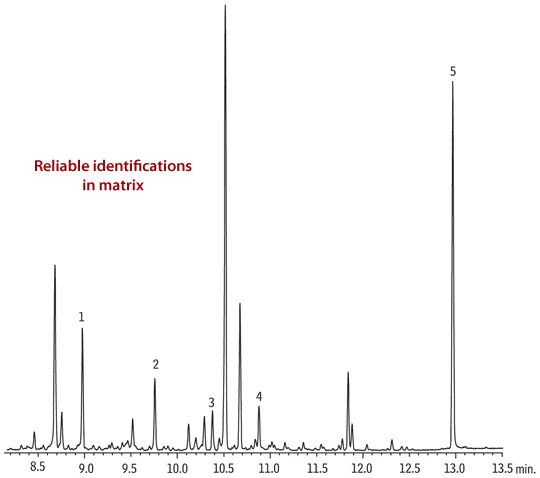01494 563377
 High Sensitivity Melamine GC/MS Analysis of Cat Food
High Sensitivity Melamine GC/MS Analysis of Cat Food
Modified Conditions Save Costs and Reduce Maintenance
By Michelle Long, Innovations Chemist and Julie Kowalski, Ph.D., Food Flavor and Fragrance Innovations Chemist
- Excellent results in pet food matrix; lower pyridine background for better sensitivity.
- Easy sample preparation; reduced derivatization reagent volume lowers costs and keeps inlet and column clean.
- Modified conditions reduce maintenance and extend filament lifetime.
Abstract
Gas chromatography/mass spectrometry (GC/MS) was used to analyze for melamine and related compounds cyanuric acid, ammelide, and ammeline. The method used was based on FDA method GC-MS Method for Screening and Confirmation of Melamine and Related Analogs, Version 2, May 7, 2007.1 Several changes were made to this method to optimize performance. The analytes were easily identified by reliable retention time matching and mass spectra. Analyses of high and low spike levels in dry cat food were successful as matrix components did not coelute with compounds of interest.
Introduction
A large pet food recall occurred in 2007 when animals became ill after eating contaminated food, some animals eventually died. There was a suspected link between the sick animals and melamine contamination, although melamine was believed to have low or no toxicity.2 Melamine is an industrial chemical used for the production of plastics, adhesives, flame retardants, fabrics and other materials.3 Melamine is not a food ingredient but was found to be present in pet food and other protein-containing goods. It is believed that the toxicity is due to the combination of melamine and cyanuric acid forming insoluble crystals. The crystals can form in the kidneys, causing sickness and eventual renal failure.4
As the investigation continued, it was determined that melamine and melamine byproducts were intentionally added to vegetable protein products like wheat gluten and rice protein. This is done to artificially elevate the protein content values of products. The Kjeldahl method is used to determine protein content. This method works by testing for nitrogen content. When protein is digested, nitrogen is released and converted to ammonia. The amount of ammonia is determined by titration and is correlated to the amount of protein present. This method yields falsely high numbers when nonprotein nitrogen is in the sample. Melamine and melamine production byproducts were added to protein products to gain higher protein content. The structures of melamine and related compounds, pictured below, show very high nitrogen content, which make them ideal as nonprotein nitrogen sources. Unfortunately, the melamine production byproducts contain not only melamine, but also cyanuric acid, ammeline, and ammelide, which cause toxicity in pets. Due to the adverse effects of melamine contamination, imported products need to be tested for the presence of melamine, cyanuric acid and related compounds.
| Figure 1:Melamine and related compounds are nitrogen rich and can artificially raise labeled protein content when used as an additive. |
|---|
 |
Procedure
The procedure for this experiment was adapted from the U.S Food and Drug Administration (FDA), GC-MS Method for Screening and Confirmation of Melamine and Related Analogs, Version 2, May 7, 2007. 1
Sample prep: Melamine and its related analogs were purchased from TCI America. All solutions were prepared under the specified method conditions. This includes all stock solutions, mixed standard spiking solution, as well as high and low standards. The high standard consisted of the mixed standard solution (100 µg/mL) diluted to 10µg/mL and the low standard was diluted to 1µg/mL. Dilutions were made with 10:40:50 diethylamine:water:acetonitrile. The extraction procedure was performed with dry cat food purchased from a local grocery market. Three 0.5g matrix samples were prepared: one as the control, one with a high spike level and one with a low spike level. The mixed standard solution was also used to spike the matrix. The high level spike used 250µL of the mixed standard solution and the low spike level contained 50µL.
Derivitization: A total of eleven samples went through the entire derivitization procedure. These samples included solvent only, singles of each compound, the internal standard, high and low standards, and the blank, high and low matrix. The derivitization procedure closely followed the recommended method. Two modifications were made to the FDA method. The amount of derivitizing reagent was reduced from 200µL to 50µL of BSTFA with 1% TMCS (cat # 35606). This is still a molar excess of 50:1 for the derivitization reagent. Incubation time was subsequently increased from 45 min. to 120 min.
Instrument Parameters: Analyses were performed on a Shimadzu QP-2010 Plus gas chromatograph mass spectrometer (GC/MS) equipped with an AOC 20i+s auto injector and sampler. An Rtx®-5MS 30m x 0.25mm ID x 0.25µm column was used for the analysis. The injector was in splitless mode (1 min. hold) with 1µL injection volume at an inlet temperature of 280°C. Helium was used as the carrier gas set at constant flow 1mL/min. The oven program had an initial temperature of 75°C, then immediately ramped at 15°C/min. to 320°C (hold 4 min.). The transfer line temperature was set at 290°C and the ion source temperature at 190°C. The mass spectrometer data was acquired in SIM acquisition mode with selected ions for each analyte of interest (Table I). The filament delay was set at 8.1 min. to decrease the presence of pyridine, and the dwell time for each ion was 0.15 sec. This gave a total run time of 18.67 min.
Table I MS conditions (SIM mode)
|
Compound |
Retention Time (min.) |
Target Ions |
Reference Ions |
Reference Ions |
Reference Ions |
|---|---|---|---|---|---|
| Cyanuric Acid | 8.97 | 345 (100)* | 330 (36) | 346 (30) | 347 (15) |
| Ammelide | 9.79 | 344 (100) | 329 (58) | 345 (30) | 330 (16) |
| Ammeline | 10.44 | 328 (100) | 343 (79) | 329 (29) | 344 (24) |
| Melamine | 10.97 | 327 (100) | 342 (53) | 328 (30) | 343 (17) |
| Benzoguanamine | 13.18 | 316 (100) | 331 (68) | 332 (20) | 330 (9) |
* Relative ion ratio
Data Processing: All data processing was done on the Shimadzu Lab Solutions software (GCMS solution version 2.5 SU1). The individual standards were used to create a user library in order to identify the compounds in the matrix samples. Chromatograms of standards and matrices were compared using the data comparison function of the software.
Results
Figure 2 shows a chromatogram of the high standard mixture using the method conditions in the FDA screening method. The chromatogram shows an elevated baseline at the beginning of data collection that slowly decreases.
| Figure 2: Original method produces an elevated baseline, compromising integration and reducing sensitivity (10µg/mL standard). | ||||||||||||||||||||||||
|---|---|---|---|---|---|---|---|---|---|---|---|---|---|---|---|---|---|---|---|---|---|---|---|---|

GC_FF00979
|
This is due to the presence of pyridine which is the sample solvent. Pyridine is necessary for the derivatization reaction performed during sample preparation and can increase ion signal background over a long period of time. To combat this, pyridine can sometimes be evaporated and the remaining analytes can be dissolved in a different more GC-amenable solvent. It is possible to lose some analytes during this process and it adds a lengthy step to sample preparation. Pyridine ion signal can be eliminated by simply changing the mass range used for the scanning mass spectrometer method. All of the analytes have characteristic ions of interest well above m/z 79, which is associated with pyridine. The scan method was modified to begin scanning at m/z 85.
A couple of modifications were made to help minimize stress to the instrument. The amount of derivatizing reagent was reduced to help maintain a clean inlet and column, as well as reduce the cost of analysis. The FDA method suggests a solvent delay time of 6 minutes. This was increased to approximately 8 minutes because of high pyridine levels, derivatization reagent, and matrix components. Adding this extra time helps to increase the filament lifetime but still ensures all the analytes will be detected.
Figure 3 shows a chromatogram of the high mix standard using the new method. This method provides excellent separation of melamine and cyanuric acid, the suspected toxic compounds, as well as ammelide and ammeline.
| Figure 3: Excellent separation of melamine and related compounds using modified conditions (10µg/mL standard). | ||||||||||||||||||||||
|---|---|---|---|---|---|---|---|---|---|---|---|---|---|---|---|---|---|---|---|---|---|---|

GC_FF00978
|
Figure 4 shows the analysis of dry cat food spiked with melamine, cyanuric acid, ammelide, ammeline, and the internal standard benzoguanamine. Reproducible and reliable retention times, along with SIM mass spectrometric detection, allow easy identification of analytes at both the high and low spike levels.
| Figure 4: Melamine production analytes are easily identified in cat food using SIM analysis (50µg/g spike). | ||||
|---|---|---|---|---|

GC_FF00977
|
||||
Conclusions
This work demonstrates that the FDA method is a valuable guideline for analysts screening melamine and related analogs. Using an Rtx®-5MS column and modifying the original method provides additional benefits: 1) decreasing the derivitization reagent volume results in longer column lifetime and less inlet maintenance, and 2) increasing the solvent delay decreases pyridine ion background, resulting in approximately 5-fold higher sensitivity for the analytes of interest.
References
- GC-MS Method for Screening and Confirmation of Melamine and Related Analogs, Version 2, May 7, 2007, U.S Food and Drug Administration , http://www.fda.gov/cvm/GCMSscreen.htm.
- FDA Recalls Animal Feed Tainted With Melamine From U.S. Supplier, Steven Reinberg, HealthDay Reporter, http://www.healthfinder.gov/news/printnewsstory.asp?docID=605070.
- Flame-retarding plastics and Elastomers with Melamine, Weil ED and Choudhary V, Journal of Fire Sciences 13 (2): 104-126 Mar-Apr 1995.
- Final report on the safety assessment of melamine/formaldehyde resin, Anderson FA, Journal of the American College of Toxicology 14 (5): 373-385 Oct 1995.

